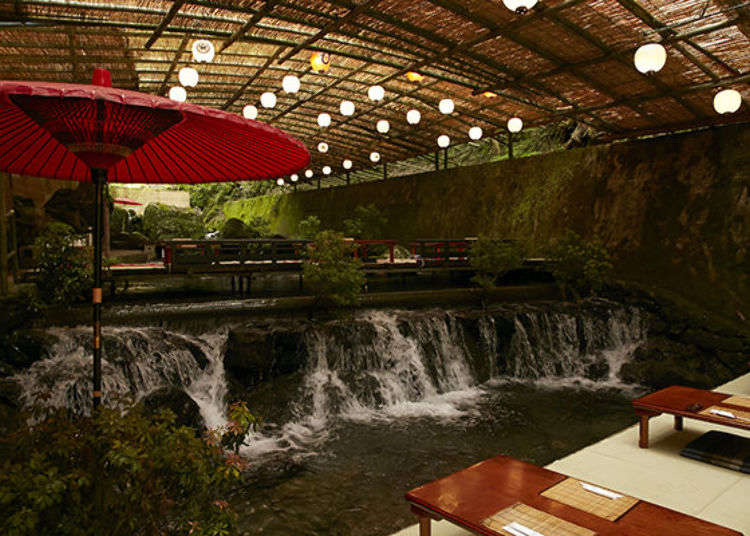
When it comes to Kibune restaurants, you have to try the 'kawadoko', or riverside restaurants. These are a well-known summer tradition of Kyoto, along with the 'noryoka,' or outdoor terraces, on the Kamogawa River. These are small tatami rooms above the Kibune River in which you can enjoy a delicious meal while taking in the cool, summer breeze.
To make the most of this luxury only to be experienced at this time of year, I took a trip to Kibune in the early part of summer.
- Table of Contents
This area in summertime Kibune is 10C cooler than the city

The kawadoko culture started in Kyoto, about 400 years ago during the Azuchi-Momoyama Period, until the Edo Period. It began when establishments such as tea shops along the Kamogawa River would line up shogi, or little folding stools, for people to enjoy the cool evening outdoors.
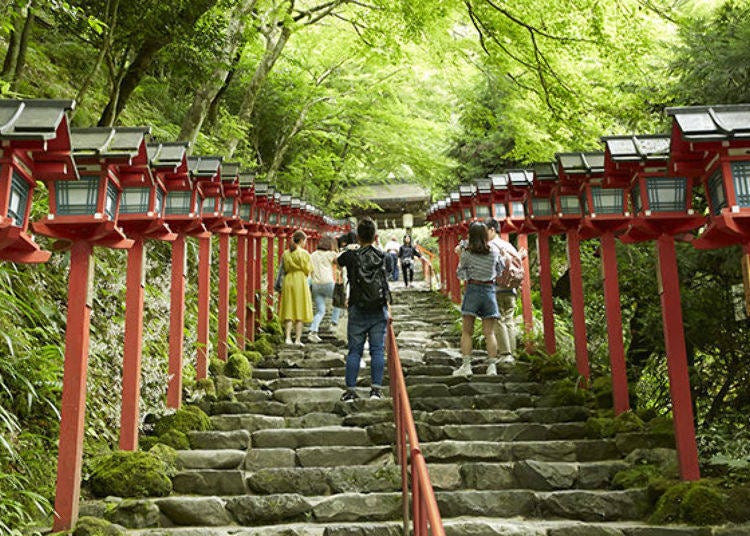
Kibune is one of the water sources of the Kamogawa River that flows through the center of Kyoto. It is also known as the place where the god in charge of the water in Kyoto resides at the Kibune Shrine.
Boasting some of the oldest history in Kyoto, Kibune Shrine is known as a power spot where many worshippers have come since long ago. The ryokan and teahouses along the Kibune River and near the shrine offer relaxation to shrine-goers.
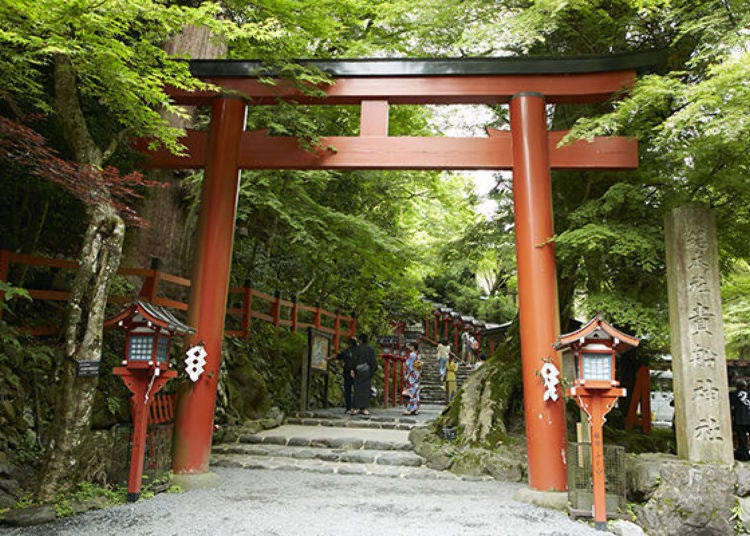
The kawadoko of Kibune began in the Taisho Period. It is said that the origin of the teashop noryoka being positioned on the surface of the river was because tourists would come to Kibune, known as a summer retreat spot since long ago, and look for a spot to dip their feet in the water.
Dining at Ryori Ryokan Hirobun

There are currently several dozen shops in Kibune that also have kawadoko on the river. Just about every shop is established along a floor built above the river, and you can try delicious dishes in each one.
This time, I visited the reputable 'Ryori Ryokan Hirobun' in order to enjoy some authentic kaiseki cuisine and the nagashi somen. Take the Eizan Electric Railway to Kibune-guchi Station. From there it is a 30-minute walk away, or you can take Route 361 to Kitakami. It is also accessible from there by bus to the nearest stop, Kibune Station, and takes about 10 minutes.

At the entrance, the kaiseki cuisine and the nagashi somen (soba noodles which flow down long flumes of bamboo to be caught and eaten) sections are separated. This is the kaiseki side. When you enter, there will be shop staff standing around to guide you to your desired section.

This is the kaiseki room. The red carpeting, umbrellas, and lanterns are quite a sight. The river flows right by your feet, and is only centimeters away from the floor. You can even stick your hand inside by reaching out. Looking up you see green leaves growing on the bamboo screen covered roof, signaling the arrival of summer.
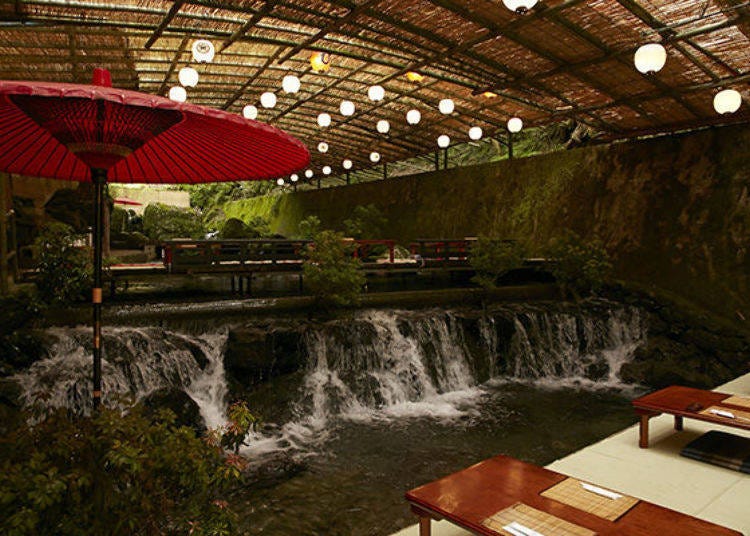
There are also seats where you can see a waterfall. The sound of the waters gushing are anything but quiet, however they flow with such a rhythm that it is soothing to the ears, and gradually relaxes the mind.
The air brought in by the river was a little chilly for being the beginning of summer. In fact, though the average temperature in downtown Kyoto is about 35C (95F), Kibune is nearly 10C degrees cooler, at about 25C (77F). It is a coolness that can be likened to nature's air conditioning.
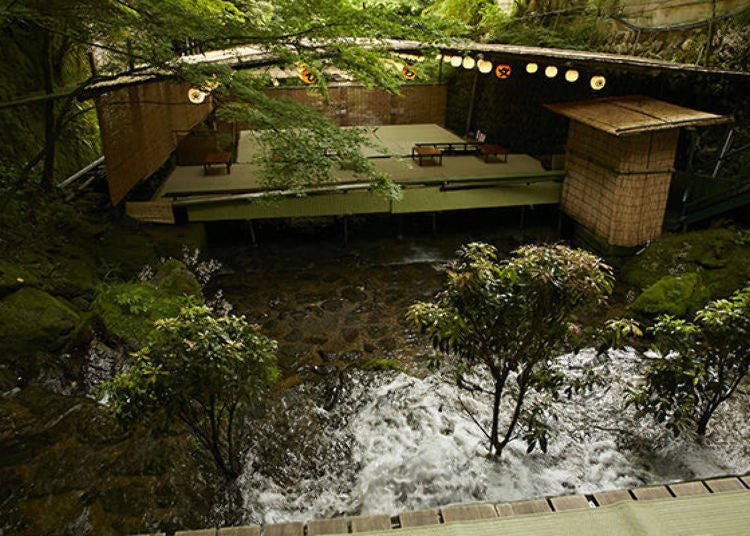
A cool summer experience! Trying out the popular nagashi somen floating noodles
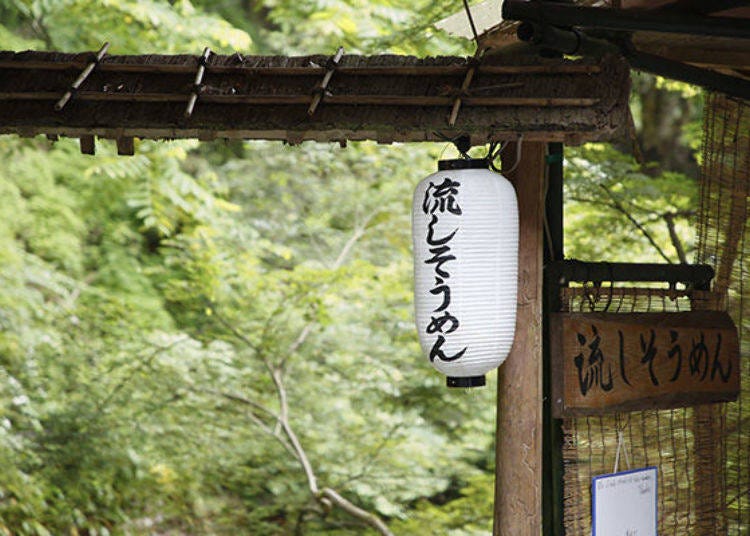
First, allow me to introduce the nagashi somen. Being able to eat these chilled noodles while watching the water flow by is nothing short of a fancy experience. It is so popular there is often an hours-long wait, and many visitors. With many visitors from abroad, at the time of publishing this (6/19/2018), there were even many tourists waiting while taking pictures.
Though such a popular item, the nagashi somen is reasonably priced at ¥1300 (tax included). However you cannot reserve a seat in advance, so depending on the circumstances, be prepared to find that you may have to wait a while. It is recommended to schedule yourself ample time just in case.
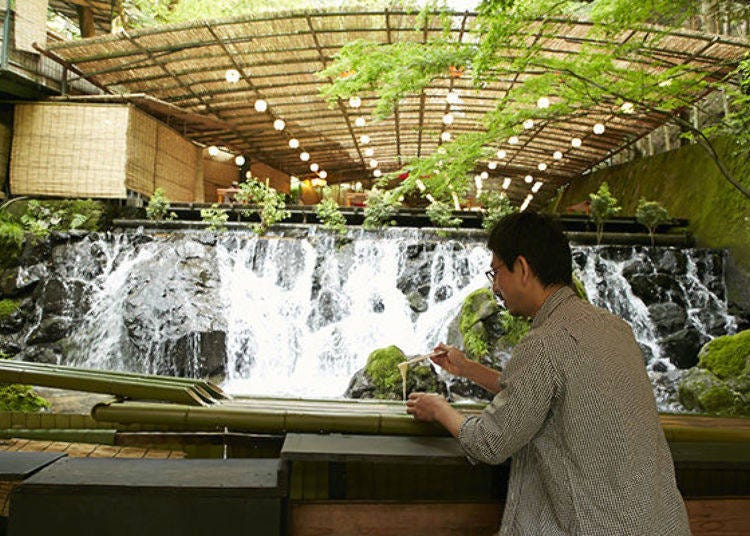
And now, it is time to try the somen. There are six bamboo flumes, divided into one per group, with water flowing smoothly through them. Holding my bowl and chopsticks, I watch and wait...

There it goes!
The pure white somen noodles flow down in bite-sized clusters. Light in weight and moving at a leisurely speed, it is perfect enough to pick up with just one chopstick.
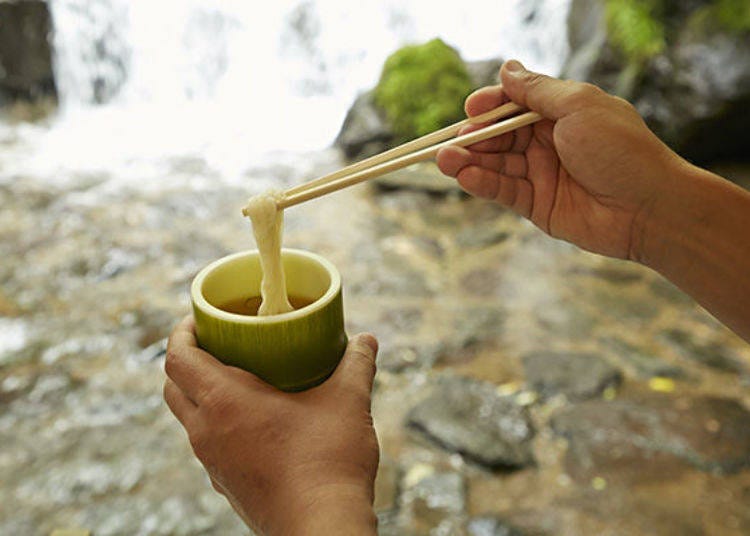
After putting the somen I picked out in the soup, it's time to eat!
"Slurp, slurp... Mmm!" It's so delicious!
Probably because of the good water quality, I could taste the somen very clearly. I personally liked the tsuyu dipping sauce, which was a little dense to prevent thinning out. There was also plenty of wasabi.
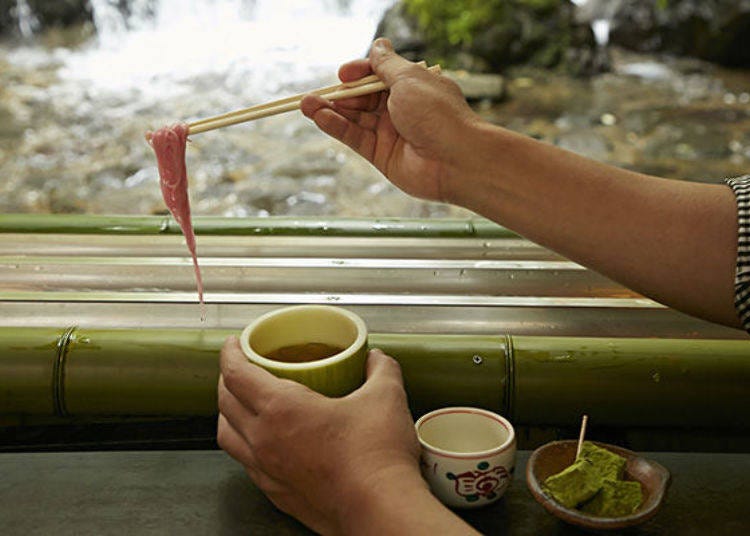
The somen flows down through the water to be picked up and placed in the soup several times. When the red somen as seen in the photo comes down, it has come to an end. These noodles are very flavorful, and a good way to wrap up the meal.
Listening to the sound of the waterfall while enjoying nagashi somen in the cool breeze... such a luxurious experience that won't be easily found elsewhere.
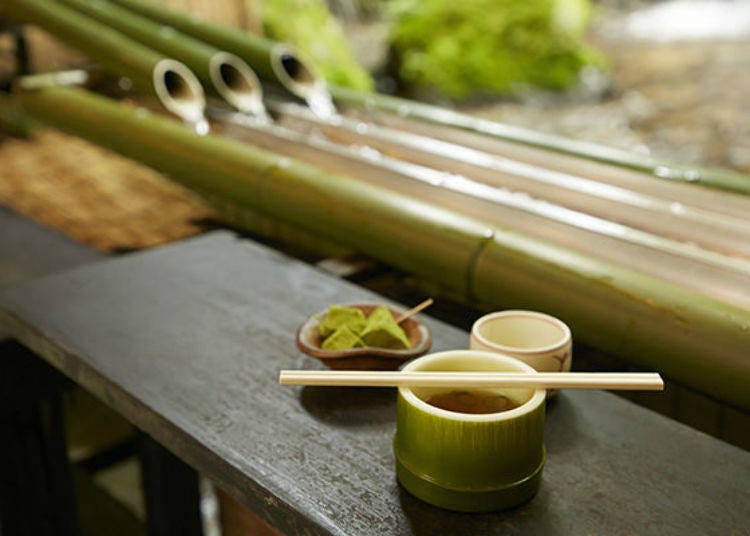
Enjoy a real authentic and refreshing Kibune summer cuisine with every dish!
There are a variety of dishes to choose from at Hirobun, including a limited-time meal, available around May/June from Monday through Friday (¥3,800, tax included); authentic kaiseki kawadoko cuisine (¥8,600~13,000, tax included; price may vary depending on contents of the meal); specialty unagi-don (¥8,000); hamo (eel) courses (¥14,000) and more.
*Room available for 2 people or more. Food ingredients may vary depending on season
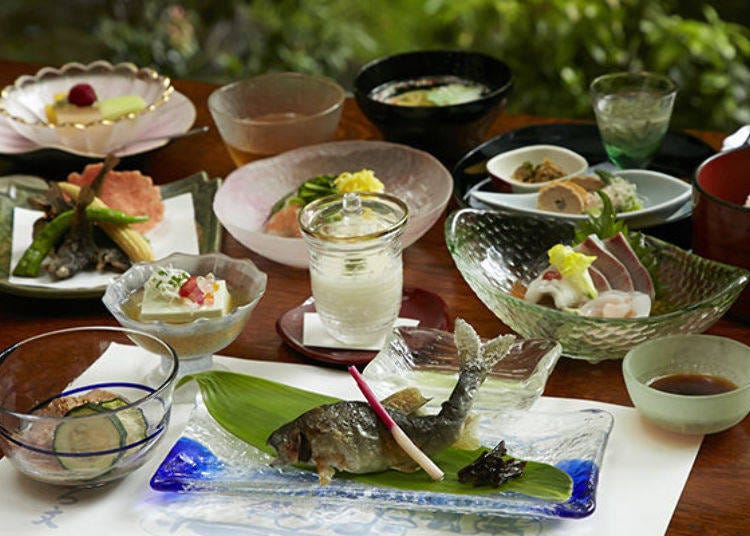
The line-up includes 11 dishes: hassun (seasonal dish), sashimi, soup, takiawase (boiled vegetables), yakimono (broiled food), aburamono (fried food), rice, pickled vegetables, and dessert. There is quite a variety of local dishes using seasonal ingredients. Here are some I found particularly delicious.
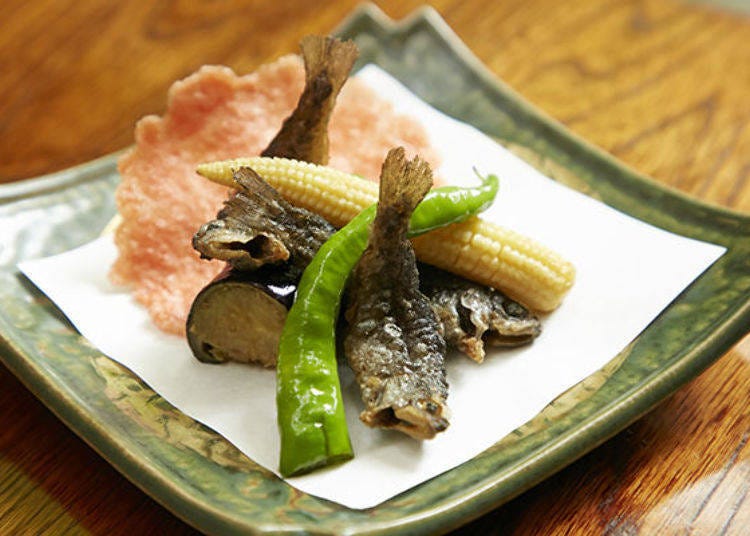
First is the fried amago. Amago is a fish from the same family as salmon and trout, characterized by red spots on the body. It is a delicious fish with a light and pleasant taste.
These small amago can be eaten whole, including the head, and have a fried, crispy aroma.
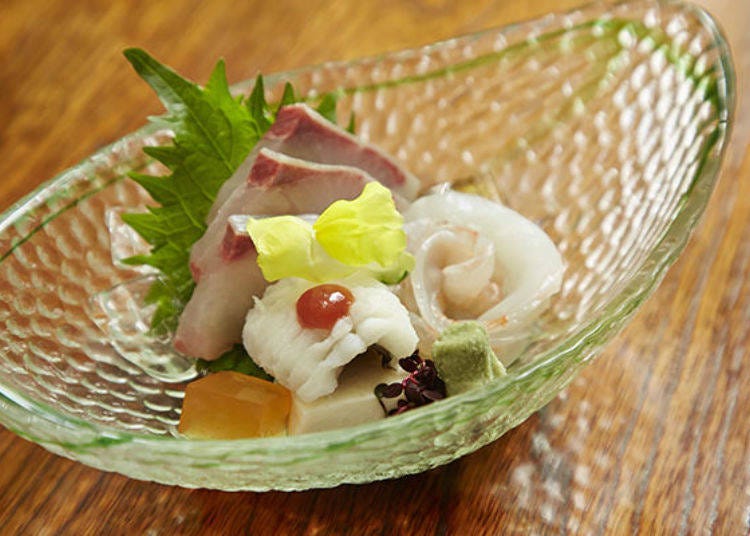
Next is the hamo, a type of eel, unique to this season. The meat of the hamo is light and chewy, and goes well with the refreshing taste of ume (Japanese plum). It is also recommended to eat it together with the soup. The shrimp and squid sashimi were served with great detail in the shape of a petal.

And finally, dessert. Today it was melon and yellow peach, with yamamomo (bayberry) and a peach agar jelly. With the seasonal fruit and the coolness of the kawadoko, one could really get a feel for summer in Kyoto.
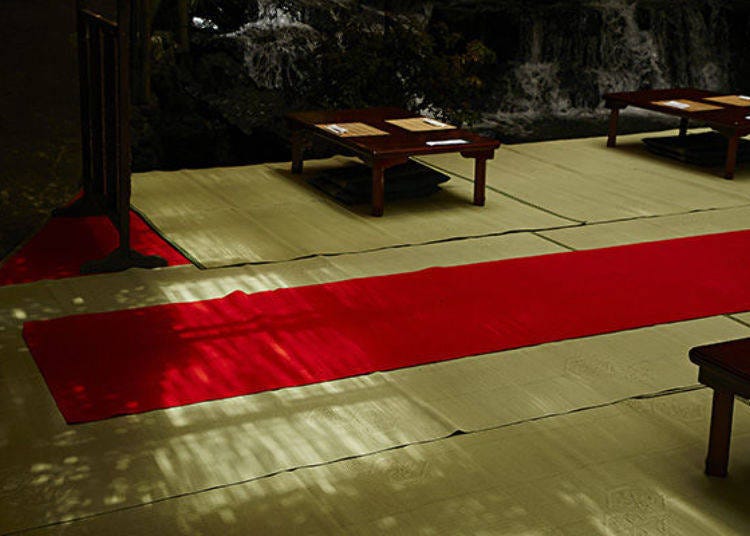
What did you think? Kibune's kawadoko is open until around the end of September. The enjoyment of the river flowing beneath the kawadoko in the mountains is quite a different experience from the busy city. Why not take the time to enjoy the summertime of Kyoto for yourself this year?
-
Ryori Ryokan Hirobun料理旅館 ひろ文
- Address 87 Kurama Kibune-cho, Sakyo-ku, Kyoto-shi, Kyoto-fu
- Phone Number 075-741-2147
Hours:
11AM~9PM, Nagashi Somen 11AM~6PM
(Reception until 1PM)
Kawadoko Period: May 1~Sept 25
Closed: Dec 30~Jan 1, irregular days
Book an unforgettable experience in Kyoto!
Make your trip extra memorable by booking one of these recommended tours.
- Area
- Category
*Prices and options mentioned are subject to change.
*Unless stated otherwise, all prices include tax.
Popular Tours & Activitiess
Recommended places for you
-

Kanzenkoshitsuyakinikutabehodai Gyugyu Paradise Sannomiya
Yakiniku
Kobe, Sannomiya, Kitano
-

Jukuseiniku-to Namamottsuarera Nikubaru Italian Nikutaria Sannomiya
Izakaya
Kobe, Sannomiya, Kitano
-

Tsutenkaku Tower
Landmarks
Shinsekai, Tennouji, Tsuruhashi
-

Kambei Sannomiyahonten
Yakiniku
Kobe, Sannomiya, Kitano
-
Goods

Yoshida Gennojo-Roho Kyoto Buddhist Altars
Gift Shops
Nijo Castle, Kyoto Imperial Palace
-

ISHIDAYA Hanare
Yakiniku
Kobe, Sannomiya, Kitano
-

Everything You Need to Know About teamLab Biovortex Kyoto (2025 Insider Guide)
by: Wemmy Chau
-

Celebrate a Dreamy Barbapapa Christmas at JR Osaka Station's Twilight
by: Guest Contributor
-

November Events in Kansai: Fun Festivals, Food, and Things to Do in Kyoto & Osaka
-
Ad

Discover Timeless Beauty: Kimono-en, a Web Magazine Exploring the Spirit of Kimono
-
Ad

Experiencing Manga as Culture, Not Just Reading It: Expo 2025 with Rumiko Takahashi
-

A First Look at NEMU RESORT’s 2026 Grand Renewal in Ise-Shima: A Resort Shaped by Village, Sea, and Forest
by: Guest Contributor
Inspiration for Accommodations
-

Spacious Family Hotel in Namba: 20 Comfortable Stays for Family Fun
-

Charming Hotels to Enjoy the Spectacular Views of Arashiyama's Autumn Leaves from Your Room
-

Experience Stunning Views of Osaka Castle from Private Spaces: Top Hotels Near Osaka Castle
-

Recommended by Visitors! Arashiyama's Best-Rated Hotels
-

Family-Friendly Universal Studios Japan Hotel with Excellent Access
-

Enjoy a Comfortable Stay in Osaka! 10 Hotels with Convenient Airport Shuttle Services
-

Top 10 Recommended Hotels Near Namba Station with Great Access
-

Enjoy Night Views from Your Room! Recommended Hotels in Namba Area
-

Fine Japanese Dining in Kyoto! Top 3 Japanese Restaurants in Kiyamachi and Pontocho Geisha Districts
-

What to Eat in Kobe: 7 Local Foods You Can't Miss
-

Why Osaka Tennoji Zoo is So Popular with Foreign Tourists (Guide & Highlights)
-

This Hidden Spot Has Held the Secret to Making Kyoto Tofu Taste Good For Over 300 Years
-

3 Best Izakaya In Osaka Where You Can Enjoy Drinks and Local Dishes, Recommended by Locals
-

Dining in Osaka: Best Restaurants for Yakiniku, Sushi, Okonomiyaki & More
by: WESTPLAN
- #best gourmet Osaka
- #things to do Osaka
- #what to do in kyoto
- #what to bring to japan
- #best gourmet Kyoto
- #new years in Osaka
- #what to buy in nanba
- #Visiting Osaka
- #onsen tattoo friendly arima
- #daiso
- #Visiting Kyoto
- #best japanese soft drinks
- #japanese fashion culture
- #japanese convenience store snacks
- #japanese nail trends












